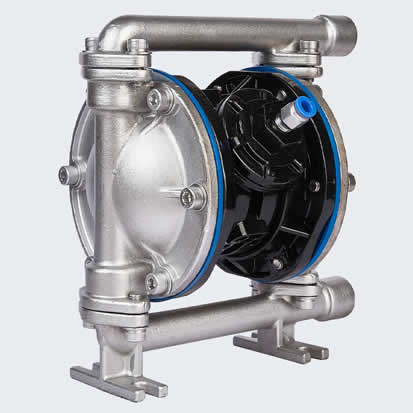Pneumatic diaphragm pump it is suitable for the ceramic industry. Environmental protection wastewater treatment and the use of modern construction sewage industry is also very good, the application of fine chemical industry is very strong, can overall expand its market share, and has an irreplaceable position. To meet the needs of different users, the device in a variety of places, if used for slightly higher viscosity fluid needs to be equipped with some reducer or frequency control system, interest is increased, but such machinery is not necessary to carry out excessive integration, in addition in some flammable and explosive environment can also be used. In many inflammable and explosive environments, the interest rate is very low, such as in the transmission process of fuel powder and explosives, which has a crucial influence, because it is impossible to generate sparks after grounding, and there is no heat generated in the work. The machine will not overheat, some sites and construction sites, due to the impurities in the ascites are more, and the composition is more complex, pneumatic diaphragm pump can play its unique role, can dispose of the waste water and sewage.
Pneumatic diaphragm pump suction pipe diameter shall not be less than the pump inlet end diameter, such as conveying high viscosity fluid, suction pipe diameter is better than the pump inlet diameter. The suction piping at the inlet must be durable and uncrumpled to produce a high vacuum. Outlet piping should be at least equal to outlet diameter, or slightly larger to reduce friction loss. All piping and fittings must be sealed and leakproof, otherwise it will reduce the self-priming capacity of the pump.
Pneumatic diaphragm pump installation: if the installation details are ignored, long-term careful planning, research and selection will still may lead to poor pumping effect and affect the service life of the pump.
Location: Noise, safety, and other logical factors often dictate where equipment should be installed. Parallel installation with conflicting requirements may lead to obstruction in the service area, affecting the installation of other pumps.
Use: The position of pneumatic diaphragm pump must be easy to use, which will facilitate maintenance personnel for daily inspection and debugging.
Air supply: Each pneumatic diaphragm pump shall have a snorkel, and the snorkel shall provide air sufficient to achieve the desired pumping flow. Air pressure depends on different pumping requirements, but does not exceed 7BAR. (125PSI)
Installation height: Please fully consider the self-priming capacity of pneumatic diaphragm pump to avoid the problem of self-priming reduction.
Line: Pump location is not determined until every possible line problem location has been considered.
Installation should be selected at a short and straight inlet and outlet line connection. Additional pipe bending and fitting facilities should be avoided. Pump body should be able to support all lines independently. Moreover, the pipeline should be arranged in order to avoid the stress of the pump body pipeline device.
Flexible hoses can be installed to eliminate stress caused by the natural round-trip action of the pump. If the pump body is to be connected to a fixed base, the placement of a cushion between the pump body and the base will help reduce the pump body vibration.
